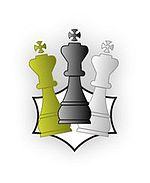
- Chess World Cup
- FIDE Grand Prix
- Olympiad
- World Championship
- List of strong tournaments
- List of world championships

- Checkmate patterns
- Chess openings
- Chess strategy
- Chess tactics
- Chess theory
- Endgames
- Pawn structure
- Problems/Compositions












| ThreeChess | |
|---|---|
 |
|
| Release date(s) | June 2010 |
| Genre(s) | Browser game Chess variant |
| Mode(s) | multiplayer |
ThreeChess is a three-player chess variant with an associated online-play website. The game features all the familiar chess moves and rules, except to win a player must capture an enemy king instead of giving checkmate.
The game San Guo Qi (三國棋, "Game of the Three Kingdoms") is a xiangqi variant and the earliest available for three players. One millennium after, in 1971 Robert Zubrin invented Three-Player Chess and started selling the game in the U.S. The game is quite popular in Europe according to many blogs and websites, and is sold in several countries. In 2010 Rumen Rachkov, Stanislav Popov, and Georgi Semerdjiev created the first online version of chess for three players and named it ThreeChess. The project started in order to participate in the Junior Achievement's Bulgaria Best Graduate Company Competition 2010. The team took first place in Bulgaria, and as domestic champions became qualified for JA-YE Europe Enterprise Challenge 2010, winning the Intel Innovation Award with ThreeChess. The website started on July 1, 2010; play is free and open to everyone.
 ThreeChess initial setup; White moves first, play proceeds counterclockwise
ThreeChess initial setup; White moves first, play proceeds counterclockwiseThreeChess is a game for three players, played on a hexagonal-shaped board containing 96 squares of alternating colors. Each player owns the same 16 pieces as in normal chess. The game is played online in Free for All mode, where players compete independently (not in teams).
As in normal chess, check is a direct attack by an enemy piece on a king, and checkmate is a condition of check that a king cannot escape. Unlike normal chess however, checkmate does not win or end the game. (When a player is in checkmate he loses his turn to move. If that player is later freed from the checkmate, he may move again.) The game ends by the capture of a king: the first player to capture an enemy king wins the game.
At the beginning of the game the chessboard is laid out so that each player has a white (or light) colored square at his lower, right-hand side. The pieces are arranged the same way for each game: the queen goes to the left of the player's king, next are the bishops, then knights, then rooks in the corners. The second row (rank) is filled with pawns.
Players choose colors by any agreed method. White moves first, followed by Green, then Black, then White again, in a counterclockwise direction. Play continues to alternate in this manner for the entire game.
As in normal chess there are only three ways a king can get out of check:
If a player has no legal move to escape check, that player is checkmated and must pass his turn and wait. Meanwhile another player may save the checkmated player with a move that removes the checkmate condition. (A likely try, since otherwise the opponent who gave checkmate may simply capture the king next move to end and win the game.)
Castling is performed the same, and with same conditions as, castling in normal chess. Castling to the right is called rightside castling in ThreeChess (kingside castling in normal chess); castling to the left is called leftside castling (queenside castling in normal chess).
En passant captures are performed the same as in normal chess.
Pawns promote when reaching the other side of the board the same as in normal chess.
Similar to normal chess, there are five ways a game may be drawn without producing a winner: